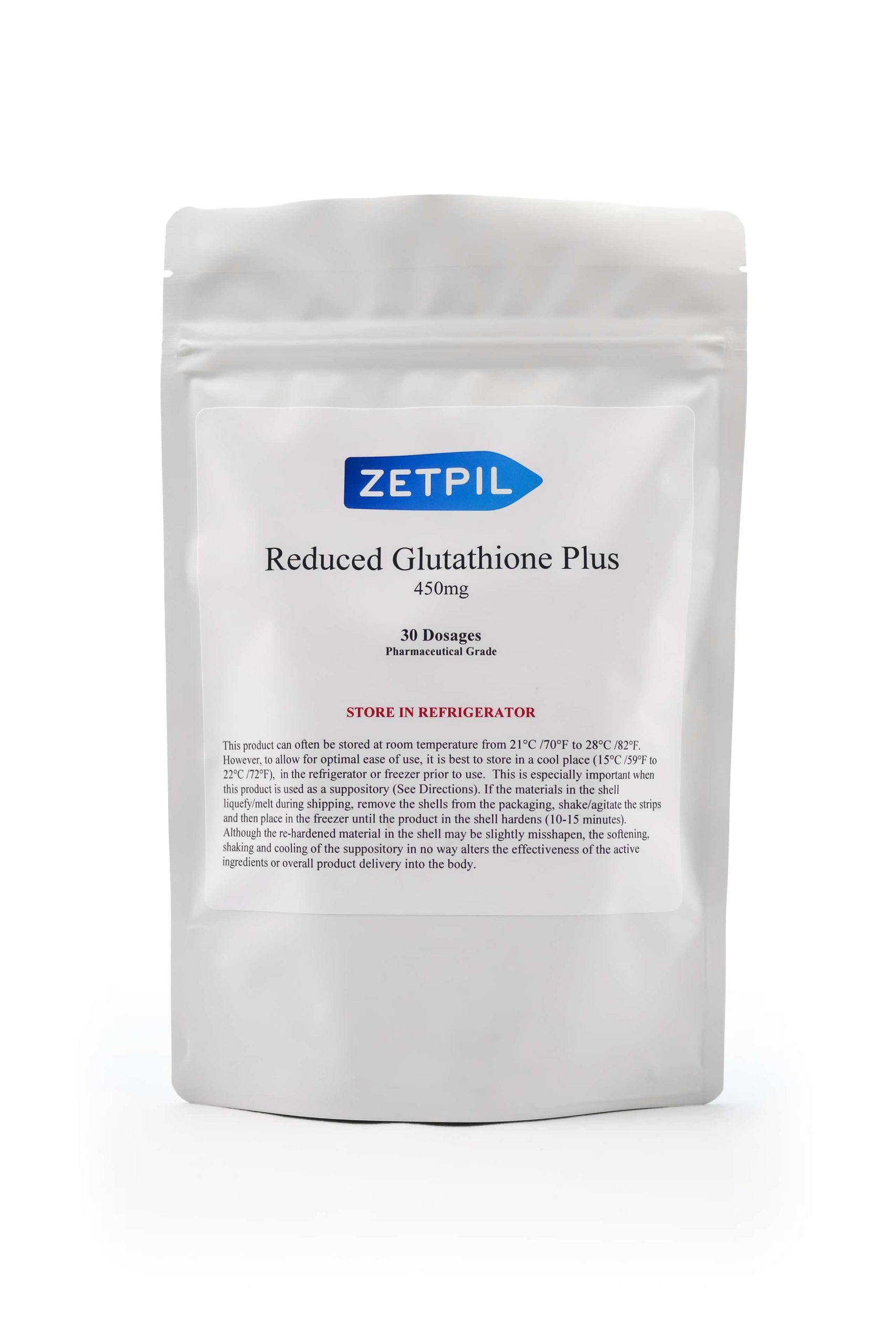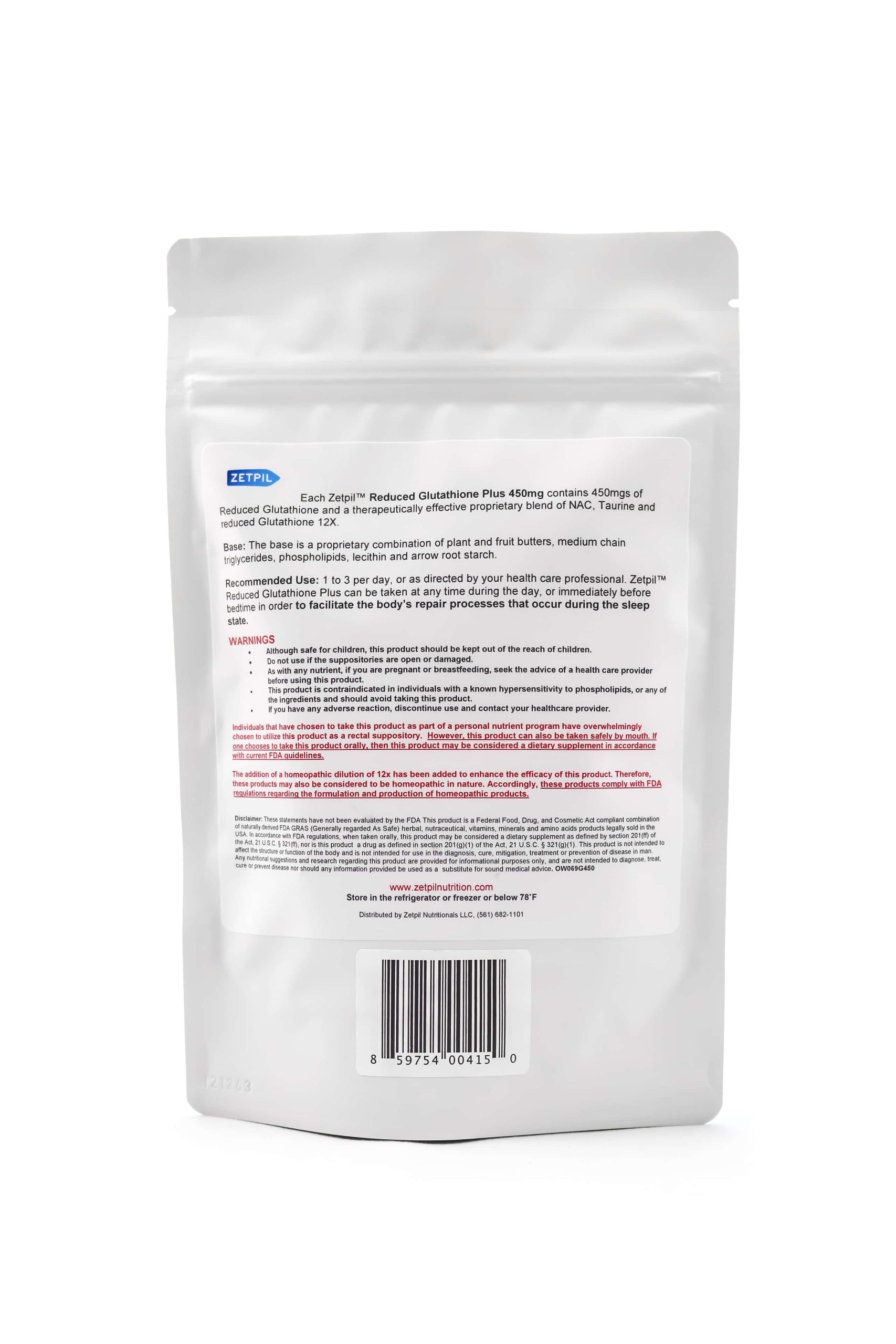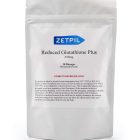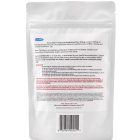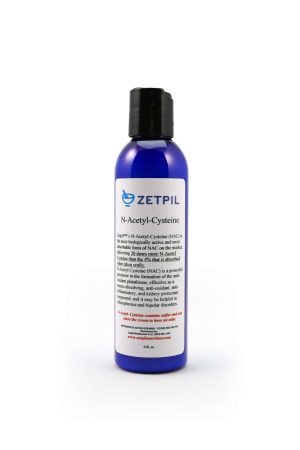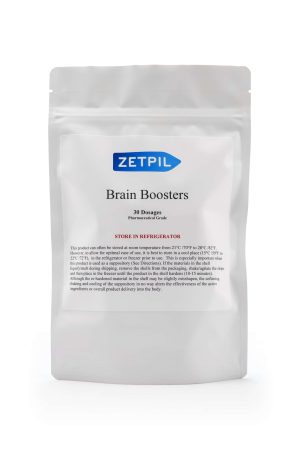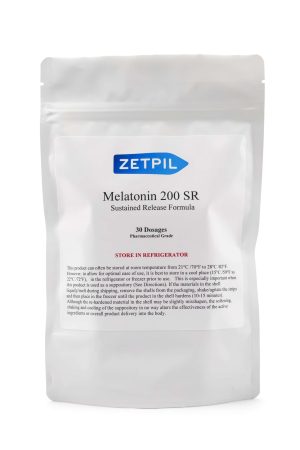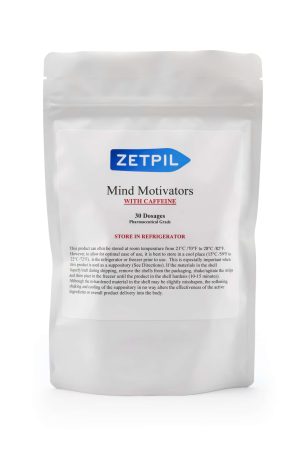Description
Zetpil™ Suppository Advantage
Zetpil™ delivers nutrition via the rectum with the use of suppositories that have a unique, all- natural formulated base that has revolutionized not only this mode of delivery, but also the ability to obtain nutrients in a far more efficacious method. These suppositories are a result of combining natural ingredients with a non-irritating, rapid melting (5-6 minutes), readily absorbable (superior retention), antioxidant base material (free radical scavenging ability) and delivers the nutrients directly into the bloodstream in less than 20 minutes in a highly effective manner. Oral supplements are exposed to the hazards of stomach acid, digestive enzymes, food-related breakdown, first pass metabolism, and other bioavailability issues in the gastro-intestinal system.
Additionally, many raw materials simply have a very low bioavailability , and only achieve around 10% or less (commonly <1%) absorption rates, even if the patient is in optimal health condition. Compromised health, age, or certain conditions that result in an inability to take oral nutrients often preclude these patient populations from obtaining the necessary nutrition to stay healthy which often exacerbates chronic health issues.
Zetpil™ suppositories are a NOW solution to delivering the necessary nutrients to patients, on a daily basis, that is both easy, comfortable and cost effective. The safety and noticeable effectiveness of these products will far outweigh any initial hesitation you have regarding this mode of delivery.
What makes Zetpil™’s Reduced Glutathione Different?
What makes this product truly revolutionary is that we have combined pure pharmaceutical grade Reduced Glutathione into our proprietary suppository base to be delivered directly into the blood stream potentially affecting an elevation of the serum glutathione levels. The cost is a fraction of IV Glutathione treatments, can be done in the comfort of your own home at your convenience, and allows for repeated administration without the time and expense of doctor visits. For a majority of the patient population pursuing the benefits of Reduced Glutathione treatments, frequent out-of-the house trips are not only bothersome, but problematic as well. Zetpil™’s revolutionary product may just be the practical solution so many are seeking.
Considering the cost, side effects and inconvenience of I.V. Reduced Glutathione treatments, the Zetpil™ solution seems both practical, easy, and more effective long-term for your health care needs. Approximately 4 dosages of Zetpil™ 450mg suppositories is the equivalent of one (1) I.V. dose absorbed.
What is Glutathione?
What is Gluthione?
Glutathione (GSH) is considered to be the most powerful, most versatile, and most important of the body’s self-generated (endogenous) antioxidants. Glutathione is found in almost all living cells with the highest concentrations found in the liver, spleen, kidneys, pancreas and the eye. It helps maintain normal brain function, protects the integrity of red blood cells, and plays a vital role in our immune function by modulating white blood cell production as well as its anti-viral properties. However, glutathione is best known for being a very powerful antioxidant.
Antioxidants are REQUIRED to prevent excess free radicals which lead to oxidative stress
Free Radicals & Oxidative Stress
What are “free radicals” and “oxidative stress”?
During respiration your body constantly reacts with oxygen for your cells to produce energy. A natural consequence of this activity is that highly reactive, unstable molecules are produced known as “free radicals”. Approximately 80% of all free radical production in the body is a result of this essential energy-generating process. Environmental stresses (ie: UV damage, pollution, radiation), emotional stress, inflammation and pharmaceutical drugs also directly cause the production of free radicals.
These free radicals (also called reactive oxygen/nitrogen species- ROS/RNS) are the nasty organic molecules responsible for aging, DNA and tissue damage, and many other types of diseases. They are called “free” because they drift around the body with at least one unpaired electron in its outermost shell until they stabilize, and “radical” because there is a large compilation of molecules from which they can snatch electrons from. As these free radicals accumulate they begin to overwhelm the body’s ability to safely stabilize them which results in oxidative stress, or damage.
How can you minimize these radicals’ damage?
ANTIOXIDANTS. Powerful antioxidants help these unstable molecules from binding with healthy molecules. However, there is a catch. What constitutes a “powerful” antioxidant may not be what you have been led to believe. One of the biggest myths touted by the nutrition industry is that all antioxidants are created equal and nothing could be further from the truth.
Many antioxidant vitamins commonly praised in mainstream medicine, such as C, E and A, are considered classical antioxidants and, in theory, are supposed to be effective in combating free radical damage. However, in the process of squelching free radicals these nutrients transform from a reduced state to an oxidized state, lose their spare electron (now molecularly unstable) and ultimately become free radicals themselves! During this process of transforming from an antioxidant to a free radical these classical antioxidants also DEPLETE one of the most basic cellular antioxidants- GLUTATHIONE. None of this is beneficial, especially since glutathione is far more powerful than the classic antioxidants.
In the end, cellular glutathione is depleted, the classic antioxidants have become free radicals themselves, and no damage has been halted, but rather promoted simply by using the wrong antioxidants to fight the battle.
Therapeutic Properties
Therapeutic Properties of Glutathione
Since glutathione is involved in a multitude of cellular processes and decreases in glutathione levels are indicative of many human health conditions, appropriate supplementation with reduced glutathione may be beneficial to one’s overall health status. Additionally, glutathione has been suggested to be helpful for, but not limited to:
- Chelation of common toxins (ie: car exhaust, cigarette smoke, alcohol and aspirin),
- Cirrhosis and fatty liver diseases or alcoholism,
- Pharmaceutical overload,
- Cataracts,
- Psoriasis, and
- Autism.
Current research on glutathione is largely centered on two key health issues: immunity and neurodegenerative diseases. Glutathione has been clinically shown to affect immune function, auto-immune diseases and viral infections. Not only are glutathione (GSH) levels depressed in these health conditions, but increasing GSH levels was shown to have positive effects.
“Interestingly, low GSH levels (and high oxidant burdens) are associated with many immune dysfunctions, including auto-immune and inflammatory diseases such as Rheumatoid Arthritis, Crohn’s disease, multiple sclerosis, and psoriasis. It has been suggested that compromised GSH levels may be a critical factor in the initial onset of these conditions.”http://www.ncbi.nlm.nih.gov/pmc/articles/PMC2756154/
Glutathione levels naturally decrease with increasing age, and therefore, its reduction contributes to the overall aging of the body. Neurodegenerative diseases are on the rise with our aging population and oxidative stress has been proven to be a major contributing factor to the onset and severity of these conditions. Glutathione may play a key role in protecting the brain from free radicals and oxidative stress, and therefore could be a prime antioxidant to help minimize this damage leading to debilitating neurodegenerative diseases.
“Glutathione (GSH) plays a key role in protecting the body against reactive oxygen species (ROS) mediated damage. Disruption in GSH homeostasis has been linked to initiation and progression of neurodegenerative diseases. Unfortunately, consuming large quantities of high-GSH foods/oral supplements does not change the levels of GSH in the body. In fact, oral intake of GSH does not increase GSH levels in the body, although intravenous dosing of GSH apparently does.”http://www.ncbi.nlm.nih.gov/pmc/articles/PMC3497002/
Supplement Facts
Supplement Facts
| Serving Size: 1 Suppository Servings Per Bag: 30 |
|
| Amount Per Serving | |
| Reduced Glutathione | 450 mg |
| Proprietary blend of NAC, Taurine and Reduced Glutathione | 12X |
| Suppository Base: The base is a proprietary combination of plant and fruit butters, medium chain triglycerides, phospholipids, lecithin and arrow root starch. | |
If you choose to use this product as a rectal suppository, it is highly recommended you attempt to clear your bowels prior to inserting it to avoid premature evacuation. To facilitate insertion it is recommended you moisten the product by passing it under a stream of cool water or use a personal lubricant. When used as a suppository, this product requires 15-20 minutes retention to ensure the complete absorption of the bioactive ingredients. This suppository can be inserted in any position. Although not required, if inserted while lying on one’s side, consider remaining in the supine position for 1-3 minutes following insertion. (Always insert flat end of suppository first).
Due to the nature of the product suppositories cannot be returned or exchanged.
Note: Zetpil™ Reduced Glutathione Plus can be taken at any time during the day. It can also be taken immediately before bed time in order to facilitate the body’s repair processes that occur during the sleep state.
WARNINGS
- Although safe for children, this product should be kept out of the reach of children.
- Do not use if the suppositories are open or damaged.
- As with any nutrient if you are pregnant or breastfeeding, seek the advice of a health care provider before using this product.
- This product is contraindicated in individuals with a known hypersensitivity to phospholipids or any of the ingredients and should avoid taking this product.
Individuals that have chosen to take this product as part of a personal nutrient program have overwhelmingly chosen to utilize this product as a rectal suppository. However, this product can also be taken safely by mouth. If one chooses to take this product orally, then this product may be considered a dietary supplement in accordance with current FDA guidelines.
The addition of a homeopathic dilution of 12x has been added to enhance the efficacy of this product. Therefore, these products may also be considered to be homeopathic in nature. Accordingly, these products comply with FDA regulations regarding the formulation and production of homeopathic products.
Disclaimer: These statements have not been evaluated by the FDA. This product is a Federal Food, Drug, and Cosmetic Act compliant combination of naturally derived FDA GRAS (Generally regarded As Safe) herbal, nutraceutical, vitamins, minerals and amino acids products legally sold in the USA. In accordance with FDA regulations, when taken orally, this product may be considered a dietary supplement as defined by section 201(ff) of the Act, 21 U.S.C. § 321(ff). Also, this product consists ONLY of a combination of naturally derived FDA GRAS (Generally regarded As Safe) herbal, nutraceutical, vitamins, minerals and amino acids products legally sold in the USA. Therefore, this product cannot be considered a drug as defined in section 201(g)(1) of the Act, 21 U.S.C. § 321(g)(1). This product is not intended to affect the structure or function of the body and is not intended for use in the diagnosis, cure, mitigation, treatment or prevention of disease in man. Any nutritional suggestions and research regarding this product are provided for informational purposes only, and are not intended to diagnose, treat, cure or prevent disease nor should any information provided be used as a substitute for sound medical advice.
References
References
There are more than 103,000 free scientific, peer-reviewed articles on glutathione at the National Library of Medicine. Please learn more by following this link:
http://www.ncbi.nlm.nih.gov/pmc/?term=glutathione
Dysregulation of Glutathione Homeostasis in Neurodegenerative Diseases
Nutrients 2012, 4(10), 1399-1440
William M. Johnson, et al
http://www.mdpi.com/2072-6643/4/10/1399
Impaired Glutathione Synthesis in Neurodegeneration
Int. J. Mol. Sci. 2013, 14(10), 21021-21044,
Koji Aoyama, et al
http://www.mdpi.com/1422-0067/14/10/21021
Glutathione and mitochondria
Front Pharmacol 2014 Jul 1; 5:151
Ribas V, et al
http://www.ncbi.nlm.nih.gov/pmc/articles/PMC4079069/
Glutathione: new roles in redox signaling for an old antioxidant
Front Pharmacol 2014 Aug 26; 5:196
Aquilano K, et al
http://www.ncbi.nlm.nih.gov/pmc/articles/PMC4144092/
A clinical trial of glutathione supplementation in autism spectrum disorders
Med Sci Monit 2011; 17(12): CR677–CR682
Janet K. Kern, et al
http://www.ncbi.nlm.nih.gov/pmc/articles/PMC3628138/
Glutathione and infection
Biochim Biophys Acta 2013 May; 1830(5):3329-49
Morris D, et al
http://www.ncbi.nlm.nih.gov/pubmed/23089304
Intravenous Glutathione Therapy- Application in ASD and Parkinson’s Disease
IHP December 2008/January 2009; pgs. 74-77
Jonathan Prousky
Application in Autism and Parkinson’s Disease (2008/2009)
Low Serum Glutathione Peroxidase Activity Is Associated with Increased Cardiovascular Mortality in Individuals with Low HDLc’s
PLoS ONE 7(6): e38901.
Brian Buijsse, et al
http://www.plosone.org/article/info%3Adoi%2F10.1371%2Fjournal.pone.0038901
Glutathione
Arabidopsis Book. 2011; 9: e0142.
Graham Noctor, et al
http://www.ncbi.nlm.nih.gov/pmc/articles/PMC3267239/
The glutathione system and its regulation by neurohormone melatonin in the central nervous system
Cent Nerv Syst Agents Med Chem 2010 Dec 1; 10(4):287-97
Limón-Pacheco JH, et al

